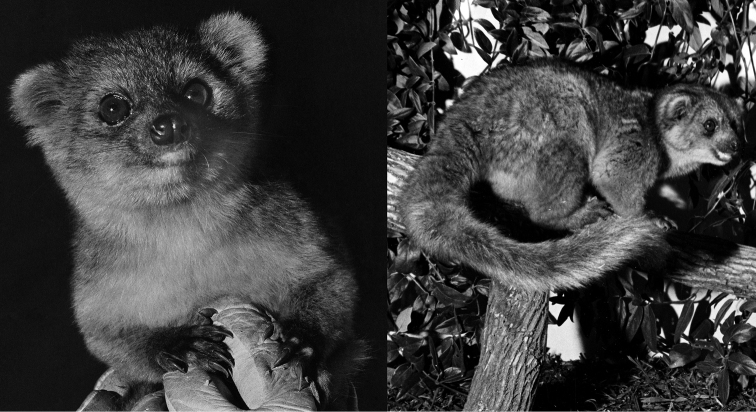
Olinguito (Bassaricyon neblina) photographed in San Miguel de los Bancos, Pichincha, Ecuador. Credit: Sylvère corre [CC BY-NC-SA 2.0 Deed]
Slinking through the forests of the North Andean cloud forests in Colombia and Ecuador is the tiny Olinguito (Bassaricyon neblina). With a face reminiscent of a cuddly toy, and reddish-brown woolly coat, it is an expert tree climber and jumper. Its arboreal lifestyle is aided by a cat-like tail that can measure up to 42.5 cm, quite extraordinary considering its body length is, on average, 35.5cm. Its long claws also work wonders for scaling up the trunks of fig trees common in Colombia’s cloud forests, where it will munch on the juicy red fruits. In fact, aside from the occasional insect, the Olinguito has quite the sweet tooth, eating mostly fruit and has been known to raid hummingbird feeders for its offerings of nectar.
Alongside taking its meals in the trees, the Olinguito rests and sleeps on branches. This might seem precarious, but for this nimble natural tree-dweller that weighs less than 1kg it easily navigates life up high. Whilst it isn’t a newcomer to the wet montane forests of the Tropical Andes – nor to observers living in or near its habitat – it is relatively novel to scientific records. For 90 years, the animal was confused for another. How did it go so long without being recognised by science as its own species?
Back in 1923, the ‘definitive specimen’ of the Olinguito was collected in Ecuador. But it was misidentified by researchers, instead being confounded with its relative the Kinkajou. Until 2013 – after being kept on museum shelves as an incorrectly labelled specimen – it was finally identified as representing a new, separate species. This made it become one of the first new species in the Carnivora order to be recorded from the Americas in 35 years – an incredible rare occurrence in the 21st Century. Following these findings, the Olinguito now sits alongside others in the family Procyonidae, including raccoons, coatis, and kinkajous.

Photograph taken in captivity, at the Louisville Zoo. Credit: I. Poglayen-Neuwall [Creative Commons Attribution 3.0]
The Olinguito is thought to be nocturnal, living a mostly solitary life and rarely leaves the safety of the treetops. Though encounters with people are rare, the future of this newly recorded species is very much in the hands of humans. It is estimated that 42% of historic Olinguito habitat has shifted to agricultural uses or urban areas. The deforestation that has been associated with these impacts make it vital that existing cloud forest habitat is protected and to restore that which has been lost..
The Olinguito is an ambassador species to the precious and delicate cloud forest ecosystem. Its Latin name, Bassaricyon neblina refers in part to the Spanish term for mist, ‘neblina’. New life is constantly being recorded here – helping humans to better understand the nature we are part of. Colombia has some of the largest remaining tracts of higher altitude cloud forest ecosystems – however, these forests are disappearing and today the country has only 10-20% of its original cloud forests remaining. It is therefore vital to safeguard these vulnerable landscapes, so that species like the Olinguito can thrive.
WLT partner Fundación Guanacas is committed to safeguarding cloud forest and its inhabitants in and around the Guanacas Reserve. You can make a difference by supporting them through our Colombia’s Forest of Mist appeal.
